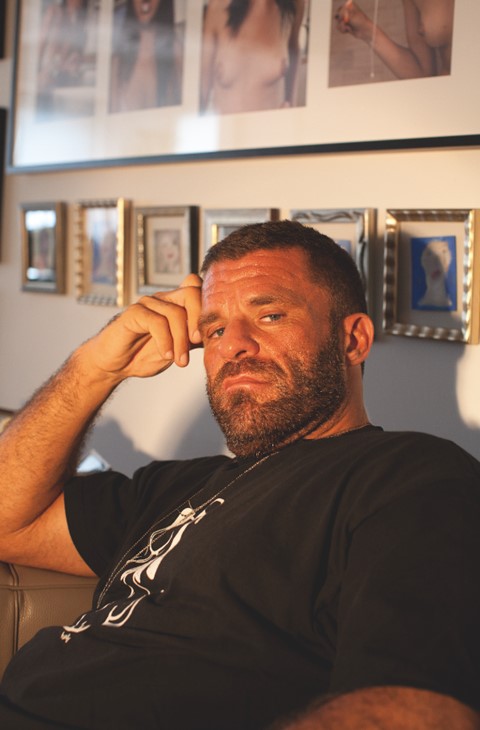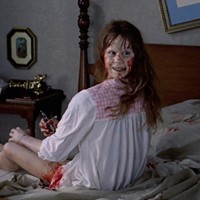In the September issue of Dazed we talk black metal, steroids, tigers and Mexican drug-lord architecture with the artist
If you just looked at Bjarne Melgaard’s paintings without any context, you’d still assume him to be a wild, transgressive bad-boy artist, with a penchant for penises, violence and tigers. Born to Norwegian parents in Australia but raised in Oslo, Melgaard made his name with installations, paintings, texts, films, collages and drawings that juggled wild brushwork, confrontational freeform text and references to heavy metal, hardcore sex, manboy fetishism, blood, toys and animals. Now aged 45, Melgaard’s work is having a whole new burst of energy. No longer pigeonholed as just the enfant terrible of Scandinavia, he is proving himself to be one of the most interesting artists of his generation, with a hard-on for beauty.
Dazed & Confused: Your work seems to be an exploration around ideas of freedom. Do you think there are limits to what freedom should be?
Bjarne Melgaard: I try not to put too many limitations on myself except for formal things. I think that some limitations are definitely necessary when it comes to abusive material or when people’s privacy is invaded, but that’s common sense. I’m working on a set of abstract paintings – I think everybody’s a little bit bored of exploitative images. Right now I feel we’ve done it too much. It has its limitations.
D&C: We’ve been overexposed to hardcore images?
Bjarne Melgaard: Definitely, by the internet, by everybody. Your work is really beginning to touch on the idea of beauty. Why? There’s always a part of my work that has beauty – maybe not in the traditional sense, but in seeing beauty where other people don’t. I worked all the black metal bands. I had my show closed by the German state. I’ve kind of been through it, done that. I feel like I want to move on. Right now a more complicated idea of beauty is something that interests me.
D&C: You’ve been curating a lot. What do you find interesting about that process of collaboration?
Bjarne Melgaard: For me it was escaping my own artistic role, and not being so eager to hang on to my artistic identity. I felt it was interesting to let everybody influence (my work) and be open with it and change it. You can go back to your work afterwards with so much more freedom, and you know that this canvas isn’t your limit. And I’m 45 and an old worn-out faggot, and it’s really nice sometimes to work with younger people.
D&C: You showed work from mentally ill students of yours at Ramiken Crucible in New York. What was the story behind that?
Bjarne Melgaard: In my studio I have a group of artists who are schizophrenic, who work in my studio and paint and just do art there. They also paint on my paintings, and I paint on theirs. It was maybe for me making a perversion out of the New York City studio situation. I used to have like, 20 assistants, and I was just so fed up with it. I said, ‘Fuck it, I don’t want that any more.’ It’s about having different mental spaces in your studio. Your studio becomes a laboratory. Even if these people have their mental disabilities, they are definitely not outsider artists or people who identify themselves as being outside. They have a strong artistic identity and expression. For me it’s been extremely important to involve myself with something that is
not ‘professional’ art life.
D&C: You also showed two baby caged-tigers in the gallery, and the animals appear a lot in your work. Why?
Bjarne Melgaard: Why the tigers? They were basically a reference from the novel I was writing in Sydney about 12 or 15 years ago. It was about a character called Tiger. It was also this idea that it was kind of dorky. People think it’s such a gimmick but it really was an experience to see that in an art context. It makes people look in a different way? Yeah. The tiger was also linked to this idea of beauty. You see something beautiful but you see it incarcerated, in a cage. These tigers are not born wild, they’re born in that environment.
D&C: You’ve written some stories and there is a lot of text in your works. What draws you to words?
Bjarne Melgaard: I’m just coming out with my first novel, the first book made in Scandinavia but written in English. It’s called A New Novel By Bjarne Melgaard. The protagonist is in the art world and he’s not sure if he has participated in something horrific or not. It’s very non-narrative and has a weird structure. It deals a lot with the idea of violence as a way of relating to the outside world but also the inside world, as something that could be a way of letting go of all your fears and hang-ups.
D&C: What draws you to violence?
Bjarne Melgaard: In this part of my work – the very graphic violent imagery, graphic violent texts – I was inspired by different writers like Guillaume Dustan and James Robert Baker, and this idea of kind of anarchist faggots through the ages going crazy. It also related to work I did with these black metal bands who have such a violent history and violence within them. But at a certain point you just feel like it doesn’t go any further, this idea of being an aggressive gay male... and not being this super-friendly fag who has 16 girlfriends and is like, every woman’s best friend. I was trying to escape that... even if I am like that!
D&C: Part of that is about conforming to social roles. Is that what frustrates you?
Bjarne Melgaard: It is difficult to locate one voice – that identity of something stable that is just there for eternity. I do this and I do that. At the ICA, I am showing a huge project, which is part of a house I’m building. I’m building three houses, putting architecture upside down. I am making the houses in collaboration with a architectural firm called Snøhetta, which built the Ground Zero pavilion and reconfigured Times Square in New York. The pictures don’t come from architectural drawings – they come from my actual drawings, which are very abstract, very hard to figure out.
D&C: You’ve painted walls, included plants and placed messed-up furniture in your work. What interests you in the context beyond your artworks?
Bjarne Melgaard: Space is very relevant. I really try to avoid doing these white-cube shows. I think the space is part of the work, not just somewhere you hang it. It needs to be renegotiated. You cannot just take a painting and then hang it on a white wall. That’s why it’s interesting for me to work with architecture. I’ve been very inspired by this Mexican form of narcotecture – do you know about that?
D&C: Narcotecture?
Bjarne Melgaard: The idea that Mexican drug lords have huge houses where they mix all styles together. They have the most expensive designer furniture with like, a plastic-covered sofa. At the ICA we will present the idea of narcotecture, and there will also be hundreds of models of different houses.
D&C: You’re having a huge burst of energy with your work. Do you feel like you’re coming through some kind of transformative moment?
Bjarne Melgaard: You need to reinvent yourself all the time – that’s where you get your energy from. If you just sit through the same thing over and over again you don’t get any energy. I make sculpture. I was commissioned to create the visual identity for a Norwegian bank. It’s important for me to move between different areas of professionalism, from very low-key galleries to an upper-class gallery like Luxembourg &
Dayan, where I’m having five floors dedicated to reconstructing five chapters of my novel using dolls and animation in collaboration with Gabe Bartalos (who does all of Matthew Barney’s work). It’s the first presentation of my novel outside of Scandinavia. I don’t want to communicate to the same audience all the time. You want to know what strangers think of your work. In the past you were really open about taking steroids. Do you think stopping has changed how you approach things? It was just a part of a culture I was in. I was in quite a hardcore music/sex world. It wasn’t something I looked upon as either strange or weird or anything. It was just something everybody did. In the end I weighed like, 280 pounds of muscle or something...
D&C: Your paintings are physical and visceral. Is that important to you?
Bjarne Melgaard: I’m very interested in the idea that you don’t observe a painting but the painting is observing you. When you have one of my paintings at home it also observes your life, which could be kind of scary.
A HOUSE TO DIE IN, September 25–November 18, ICA, The Mall, London SW17. ica.org.uk stabfrenzy.com Clockwise from top: untitled, 2010, courtesy of Lars Bohman Gallery; IDEAL POLE exhibition, 2012, courtesy of Ramiken Crucible; UNTITLED, 2008, courtesy of Galerie Guido W Baudach; THE WORLD IS FULL OF RICH CORRUPTED CUNTS, 2008, courtesy of Galerie Guido W Baudach
Photography by Adam Gong






